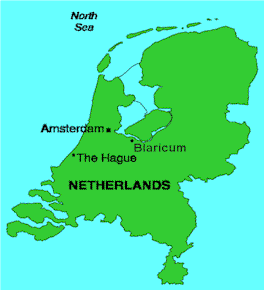![]()
The village of
Blaricum has a web
site. It is written
in Dutch.
The following is a
translation made by Bernard VanBlaricum expressly for us.
 The History of Blaricum
The History of Blaricum
Several municipal Coats of Arms in "het Gooi" are a reminder of it's agrarian past. Included in the coat of arms of Huizen is a Milkmaid. In the one of Hilversum and Bussum is buckwheat, whereas Blaricum carries in her coat of arms three blue cornflowers on a silver field. At first Blaricum did not carry a coat of arms, because there was talk of the village being added to Laren. However at the inauguration of Queen Emma they had to have a coat of arms. The only coat of arms that was known for Blaricum was a coat of arms with three corn flowers. It was because it was already named by Van Ollefen and also by Van der Aa. The origin of the coat of arms is not known. The coat of arms of Blaricum was authorised by the crown to the municipality on 14 April 1897. The formal description of the coat of arms of Blaricum: "In silver, a pulled out corn flower plant with three flowers of lazuur (violet-blue), the stem and a root of sinopel".
![]()
The name could be explained by the combination of the personal name Blaheri with the addition of "inga" with the word "heem" (dwelling-place). The geographical dictionaries, such as "Van der Aa" also give the names Blaercom, Blarikom and Blaren to indicate the village. In 1381/82 Blaricum appears again in the archives: of Hilversum, of Bladerikem and of Husen. In that year the church is mentioned for the first time, as a "daughter church' of Laren, with which it formed a "church game". Although the administration of justice for Laren and Blaricum occurred at the same time, Blaricum already had it's own village administration for committee matters, the so called mayors. The age of the place still remains ambiguous. The districts of Crailoo and Bijvanck form parts of the municipality of Blaricum. The name Crailoo most probably means Kraaienbos (crows forest or wood). It was the name of an already existing property with a liberal 50 hectares of land. This property was acquired on 16 June 1628 by Kilian van Rensselaar, a rich salesman from Amsterdam, who subsequently made it a country-seat. The name Bijvanck means separated terrain; in the countryside also refereed to as "reserved territory". The district of Bijvanck is realised on the the former area of Oostermeent in Blaricum. The word "meent" means communal pasture area and is related to the institute of "erf gooiers" ( farmyard throwers). The "erf gooiers" at that time amalgamated themselves into the Union Stad and Lande (Union City and Land), which owned all these communal pasture areas in the Gooi and gave all it's members use thereof.
![]()
Herewith a translation of a glossary (sent to Bernard van Blaricum by the
Municipality of Blaricum) of some of the terminology used in the "History
of Blaricum".
Erfgooiers = Original inhabitants of "het Gooi", who had
the rights to use the pastures and run cattle within that area. These rights
were inherited from their fathers upon reaching 18 years of age.
Vereniging Stad en Lande = Union of all the "erfgooiers"
who lived in "het Gooi". This union was disbanded in 1976 after having
been in existence for more than 1000 years.
Plaggen steken = digging of heath, sods of grass/peat used to
fertilize and improve the soil. Also used as a cheap fuel.
Lazuur = Blue color.
Sinopel = Green color.
Brinkdorp = a village that has a "brink" (village
square) usually with a church and trees.
Dochterkerk = Daughter church. A church that came forth out of an
other one.
Kerspel (not kerkspel) = Roman Catholic municipal parish.
Hofstede = Farm
Revised: June 03, 2000